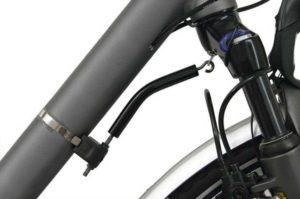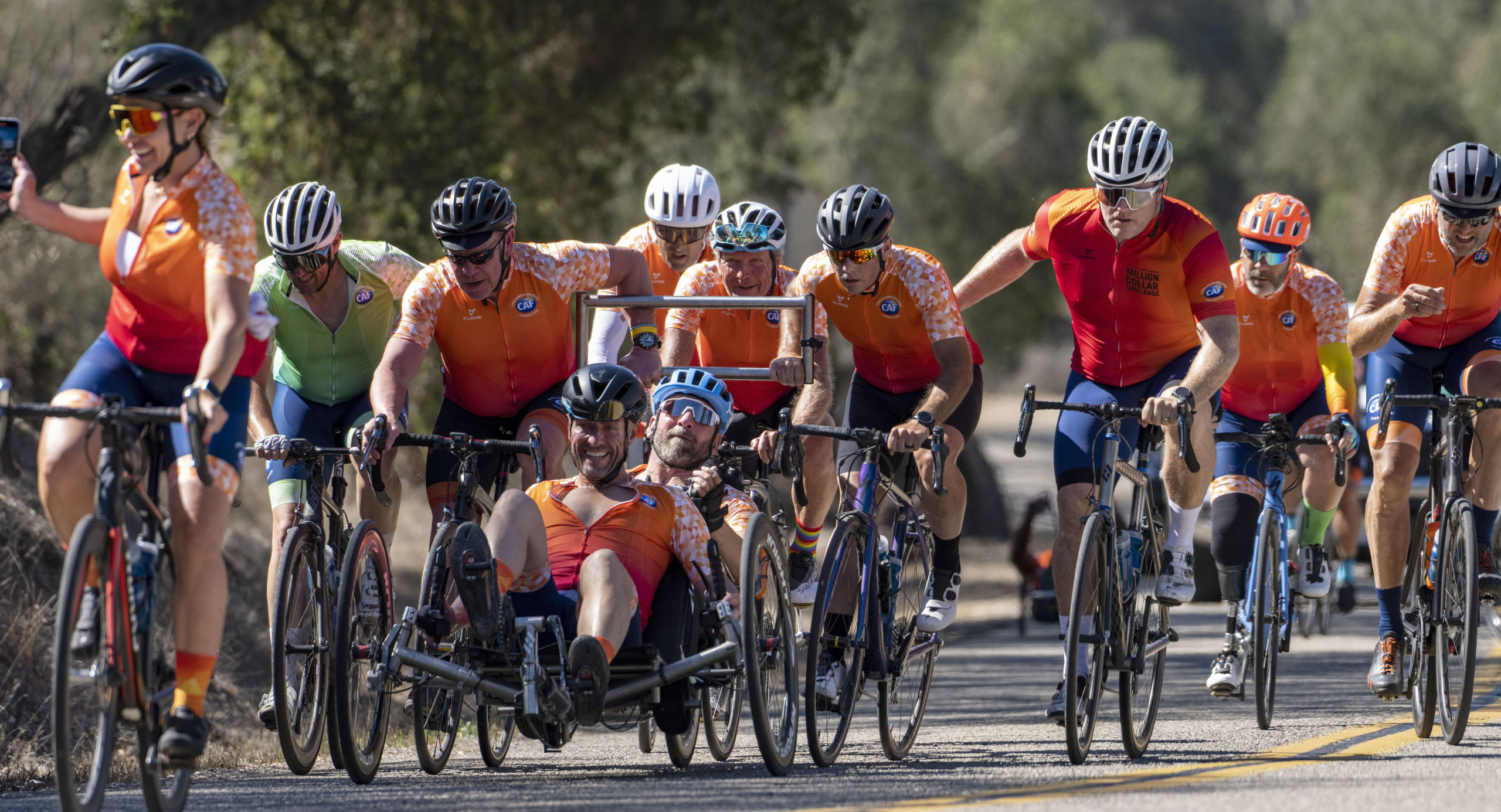Adaptive Equipment for Cycling
Adaptive Equipment for Cycling
The range of equipment for cycling includes various types of bikes, gravity dampers, leg supports, and other accessories. Scroll below to learn more…
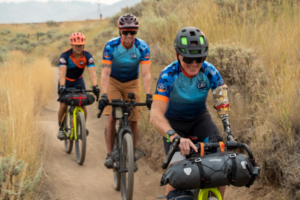
HANDCYCLES
TANDEM BIKES
RECUMBENT BIKES
CARRIER BIKES
ACCESSORIES
HANDCYCLES
A variety of handcycles are available that suit a wide range of abilities. This type of bike is propelled with force from arms through a crank system. The gears on handcycles are placed in the front of the bike opposed to other types of bikes with the gears towards the back of the bike. See below to learn more.
Recreational Handcycle
Recreational handcycles are intended for riders who are interested in biking for fun on paved surfaces.
Information and photo pulled from Top End. Recreational Handcycle.
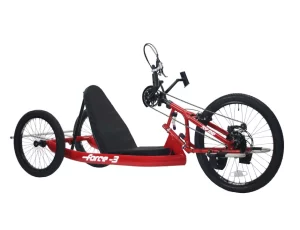
Off Road Handcycle
Off road handcycles are designed to handle rough and uneven terrain, as they have wider and more durable tires. Electric off road handcycles are another type of off road hand cycle that provides assistance with pedaling.
Information and photo pulled from Lasher Sport. Off Road Handcycle.
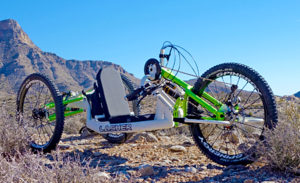
E-Assist Handcycle
E-Assist handcycles are adaptable and customizable to suit a wide range of abilities. These hand-cycles are available with hand pedals, foot pedals, and adaptive hand controls for those who have more limited arm movement. The E-Assist handcycle shown in this image has a reverse braking system, quad grips, and SRAM wireless eTAP Shifting (shifts gears through the press of a button with a finger on each grip). Pressing the left button on the SRAM wireless eTAP Shifting moves the chain to the left to an easier gear, and pressing the right button moves the chain to the right to a harder gear. A power assist option is available if preferred.
Information and photo pulled from Bike-On. E-Assist Handcycle.
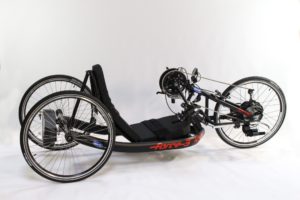
Attachable Handcycle
Attachable handcycles connect to the front of the wheelchair, eliminating the need to get in and out of a chair. A few options exist for the type of attachable handcycle, with some being propelled by a crank system with the arms, and others being propelled by a power system with control through use of thumb throttles. The device shown in this image is powered by an electric system and can handle rough terrain.
Information and photo pulled from RGK. Attachable Handcycle.
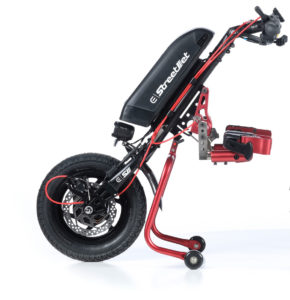
TANDEM BIKES
Tandem bikes allow for two people to ride together on the same bike. A variety of tandem bikes exist depending on an individual’s personal preference, with some having the option for electric power to assist with pedaling. These include semi-recumbent tandem bikes, tandem trikes, side by side bikes, and more. See below to learn more about the different types of tandem bikes…
Side-by-Side Tandem Bike
The side-by-side tandem bike allows the riders to sit next to each other rather than one person being behind the other. This bike offers easy maneuverability, with some of these bikes having an option to add on electric power to propel.
Information and photo pulled from Gopher Sport. Side-by-Side Tandem Bike.
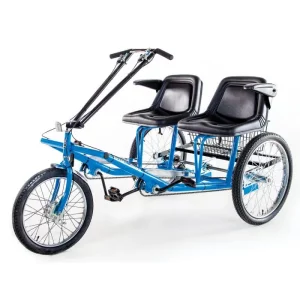
Semi-Recumbent Tandem Bike
The semi-recumbent tandem bike has a standard seat along with a semi-reclined seat with back support for the second rider. This bike has an option to add electric power to propel.
Information and photo pulled from Hase Bikes. Semi-Recumbent Tandem Bike.
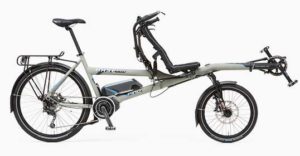
Tandem Trike Bike
A variety of tandem trike bikes are available with differing seating options to suit an individual’s preference. This tandem trike bike has two semi reclined seats to provide both riders with increased back support while riding.
Information and photo pulled from All Out Adventures. Tandem Trike Bike.
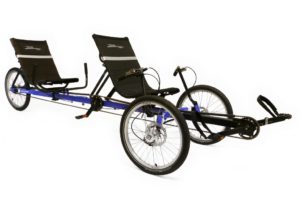
RECUMBENT BIKES
Recumbent bikes are available in varying types of cycles, such as handcycles, trikes, tandem bikes, and more. Recumbent bikes have a seat that places the rider into a reclined position. This reclined position puts less strain on the rider’s joints while cycling, increases comfort for the rider, and is easier to balance. The pedals are typically out in front of the rider and are controlled by grips on each side of the seat. Displayed below are a few examples of recumbent bikes.
Recumbent Delta Trike
This delta trike is one of many available products available for recumbent bikes. The pedals are positioned in front of the rider with brake controls on each side of the seat.
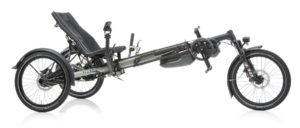
Recumbent Handcycle Bike
This recumbent bike is available for individuals who prefer to handcycle and are more comfortable being in a reclined position. The gears are controlled by a crank system with arms, with the brakes being controlled by thumb throttles.
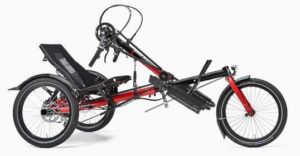
Tandem Recumbent Bike
This recumbent bike is available for individuals who like to ride with a second person, offering a reclined seat in the front with pedal controls for the front riders’ legs. The second rider in the back sits on a standard seat with their own set of pedals as well. The brakes are controlled by thumb throttles on the back of the recumbent seat.
Information and photos in this section pulled from Bike On. Recumbent Delta Trike. Recumbent Handcycle Bike. Tandem Recumbent Bike.
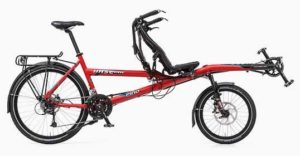
CARRIER BIKES
Carrier bikes have a seat on the front, with another seat in the back for a second rider to propel the bike for both riders. Carrier bikes allow for a rider to sit in a seat attached to the bike or roll their own wheelchair onto the bike to ride. Shown below are a few examples of carrier bikes.
Carrier Bike with Built-In Seat
This bike has a seat in the front that places the rider in a neutral position with back support. A head rest can be attached if needed, and a harness and lap belt are included to ensure increased safety of the rider in front. Arm rests can be attached to the sides of the seat, with hand protectors covering the top portion of the front wheels to prevent injury of the rider’s fingers. The seat is set lower for increased stability while biking. The person pedaling in the back seat can brake the bike by squeezing up on the stroller handlebar.
Information and photo pulled from ESpecial Needs. Carrier Bike with Built-In Seat.
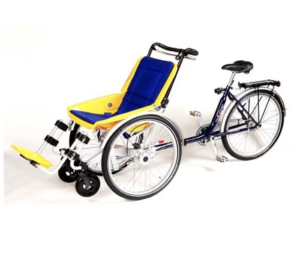
Carrier Bike with Wheelchair Platform
This carrier bike has a platform on the front for a rider to roll their personal wheelchair onto the front platform. The wheelchair easily locks into place with straps that hook onto the chair, and the rider wears a seatbelt for added safety while biking. The second rider sits on the seat in the back to pedal and steer the bike.
Information and photo pulled from Van Raam. Carrier Bike with Wheelchair Platform.
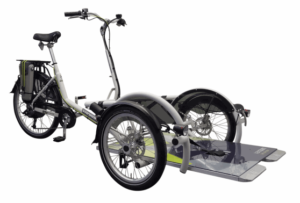
ACCESSORIES
Leg supports and positioners are available and intended to help secure an individual’s legs in place and prevent slippage of their feet while cycling. Steering dampers use a ventilation system that prevents airflow in the opposite direction. This results in increased stability while biking at higher speeds. See below to learn more…
Special Pedal with Calf Support
This pedal attaches to an individual’s bike and is intended to position and secure their leg in place while cycling. The top of this pedal has a velcro strap that attaches around an individual’s calf. Another velcro strap attaches across the top of the foot to hold the foot in place as well.
Information and photo pulled from Rad Innovations. Special Pedal with Calf Support.
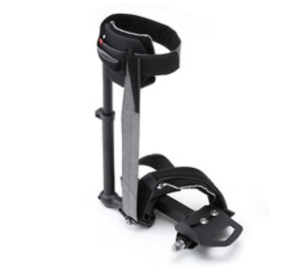
One-sided Leg Support
The one-sided leg support device is intended for individuals who have one-sided paralysis. This leg support holds the affected leg in place in a comfortable position while the other leg pedals.
Information and photo pulled from Rad Innovations. One-Sided Leg Support.
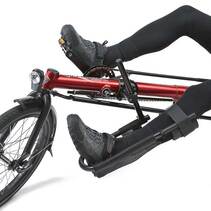
Foot Fixation Trays
These foot fixation trays attach to the pedals and are intended to hold an individual’s feet in place. The straps attach around the feet to secure them while cycling.
Information and photo pulled from Berkel Bike. Foot Fixation Trays.
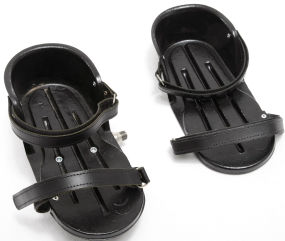
Steering Damper
Steering dampers are an available device that increase stability while biking. Use of this device helps an individual to keep their handlebar in place, resulting in less shakiness and increased stability while biking. People often use a steering damper when off-roading on uneven terrain. The steering damper helps to reduce fatigue due to gaining increased control of the handlebars.
Information and photo pulled from Bike Inn. Steering Damper.
